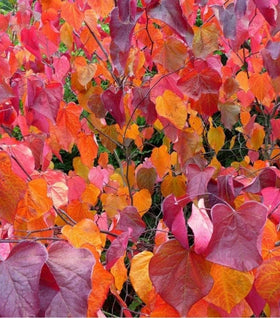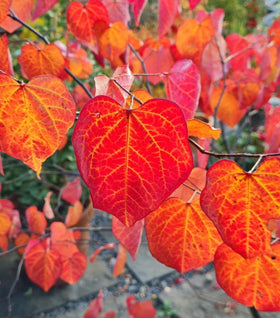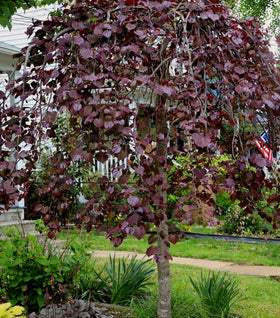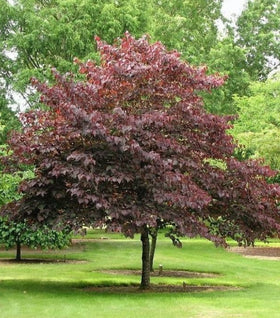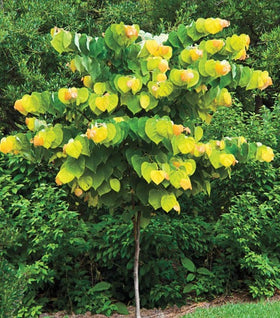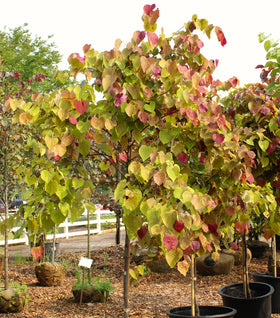Redbud Trees for Sale Online
Known as the harbinger of spring, the American Redbud’s delicate purple pink blossoms and buds put on one of the most dramatic displays when it comes to spring color. Here in Maryland it is not unusual to see redbud trees in bloom when there is still snow on the ground. But this tree’s beauty doesn’t end with its flowery show. The showy flowers are pea-like and rosy pink with a purplish tinge. Flowers develop before the leaves in spring, emerging in clusters along the branches. Redbuds bear flowers and fruits on bare branches. This is a rare trait in trees that grow in temperate climates. Flowers bloom between March and April and persist for 2 to 3 weeks. Flowers are pollinated by bees. By mid-summer the flowers are replaced by bean-like seed pods (legumes) that persist through the winter.
Benefits of the Eastern Redbud Tree
Unique and irregular branching patterns combine with a trunk that commonly divides close to the ground to create a very handsome, spreading, and often flat-topped crown. Their purple flowers appear even on young trees. The thin bark is gray and becomes scaly on older trees. Stems are slender, dark reddish-brown to black, and zig-zag.
Planting trees is an admirable thing to do. Not only will they add to the aesthetics of your landscape, but they are beneficial to wildlife as well. In the fall, their eye appeal continues as their leaves turn into a technicolor show of burgundy, orange, red, and yellow. Eastern redbud is named for where it grows, in eastern North America, and the beautiful, reddish flower buds. Other names include Judas-tree.
The Eastern Redbud Tree is an ideal garden tree. They can be used in small groupings, as specimens, and near patios. Redbuds are suitable for small sites with full sun to partial shade. It is especially beautiful in woodland and naturalized gardens.
The Eastern redbud is a relatively easy tree to grow, particularly suited to full sun to part shade and well-drained soils. The tree does equally well in acidic or basic soils. It is best planted from container-grown plants as a young tree in spring or fall as this will reduce root disturbance. Eastern redbud was introduced into cultivation in 1641. George Washington reportedly transplanted redbuds from the woods to his gardens at Mount Vernon in Virginia.
Native Range and Habitat of the Redbud Tree
Eastern redbud’s native range is New Jersey to northern Florida, west to Missouri and Texas, and northern Mexico. Trees grow on upland and disturbed sites in a variety of soils. They are not picky when it comes to caring for them.
The fruit is a flat, oblong legume that is 2 to 3 inches long. Fruit ripens in October and may persist through winter. Legumes have small, red-brown seeds that are ¼ inch long. The seeds are scattered by birds and wind.
Types of Redbud Trees
Rising Sun Redbud Tree produces abundant pea-like rosy-lavender flowers that appear in early spring before the foliage. Heart-shaped deep apricot yellow leaves appear and mature through shades of orange, gold, and yellow with all colors present at once! Foliage turns a shade of lime green in the summer heat if planted in full sun. Non-burning yellow foliage holds up well in heat and full sun. Ideal specimen or accent plant. A real show-stopper. Rising Sun redbud trees grow to be 8-12 feet and 8-9 feet wide, and they prefer to be planted in full or partial sun and are cold hardy to zone 5.
Merlot Redbud Tree is a perfect spring flowering tree for smaller landscapes. This new hybrid sets new standards for purple-leaved redbuds. Outstanding Dark Purple to Burgundy foliage is similar to Forest Pansy Redbud, but with Texas Redbud in its genes, Merlot Redbud Tree boasts excellent drought tolerance and thicker, glossier leaves that stand up to summer heat. They attract bees, birds, and butterflies. Merlot redbud trees grow 12-15 tall and 12-15 feet wide, and they prefer to be planted in full or partial sun and are cold hardy to zone 6.
Eastern Redbud Tree is one of the first trees to flower in the early spring, bursting forth with petite pink flowers in large clusters before the leaves emerge. The Rosy-Pink blooms appear in late winter or early spring. Soon after, dark green, heart-shaped leaves begin to form a beautiful backdrop, which makes the rosy-pink flowers stand out even more. Eastern Redbud is a North American Native Tree. Eastern redbud trees grow up to 30 feet tall and 15 feet wide and are cold hardy to zone 4.
Burgundy Hearts Redbud is a new selection that has proven itself with excellent color retention and added resistance to summer leaf scorch than older maroon-leaved cultivars, especially in the heat of the South East. Pink flowers are red-purple new foliage turning to wine-red burgundy in summer that holds well throughout the fall. Burgundy Hearts redbud trees grow up to 15 feet tall and 15 feet wide and are cold hardy to zone 5. They prefer to be planted in full to partial sun.
How to Plant a RedBud Tree
Here at Woodies Garden Goods Direct, we ship only top-quality potted trees, we do not ship anything bare root). We suggest when planting your newly purchased redbud trees that you dig a hole twice as wide as the root system but not deeper. Depending on the quality of your existing soil you may need to add locally sourced compost or topsoil to the back-fill soil. We do not recommend using straight topsoil or compost as a back-fill soil because more times than not these products will retain entirely too much moisture and will cause the root ball to rot. Adding compost or topsoil will help the young feeder roots of Merlot Redbud Tree to spread through the loose, nutrient-rich soil, much easier than if you used solely the existing soil which more times than not will be hard and compacted. The most common cause of plant death after transplanting is planting the new plant too deep. That is why we do not recommend planting in a hole any deeper than the soil line of the plant in the pot. A good rule is that you should still be able to see the soil the plant was grown in after backfilling the hole. Espoma Bio~tone starter plus is a great starter fertilizer that provides plants with a mycorrhizal fungus. It is a naturally occurring beneficial fungus that colonizes the new growing roots of plants. It creates a barrier between the roots of the plant and fungi and pathogens that can cause root rot. We love this product and use it on all the plants we install in our own gardens. Bio-tone is a gardener's best friend and can help guarantee your success.
Garden Goods Direct is the perfect place to buy redbud trees online. We offer expert service and reliable plants that we stand behind. If you have questions, feel free to contact our customer service team.


